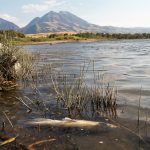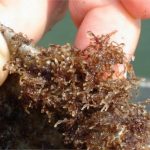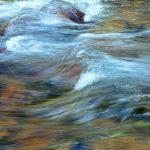Bryozoan Mapping Proposal 2018

Proposal
Mapping the Incidence of PKD Parasites in Paradise Valley, Montana
March 10, 2018
1.0 SUMMARY
The 2016 fish kill in the Yellowstone River focused public attention on proliferative kidney disease (PKD), a condition affecting whitefish and related salmon. This was the largest known outbreak of PKD in the United States, yet one year later very little is known about what actually happened. The work described in this proposal would take the first essential step in understanding PKD in the section of the Yellowstone River hit hardest by the 2016 fish kill. This knowledge will help determine the next steps to avoid or lessen the impact of future outbreaks.
2.0 BACKGROUND
What is PKD? It is a parasitic infection in salmonid fish. Once the symptoms appear, PKD is almost always fatal and there is no known cure. Among fish the disease is not contagious – it can be acquired only indirectly from an inconspicuous freshwater bryozoan.
What are bryozoans? Also known as “moss animals,” they are common invertebrates in lakes ponds, and rivers. They are always found attached to rocks or other submerged surfaces. Often they resemble plant roots or scraps of moss.

Until recently it was thought that the disease was carried only by bryozoans of the genus Fredericella. New studies from California now show that other genera may also be involved.
How do bryozoans cause PKD? Certain species can harbor microscopic parasites that release spores to infect other bryozoans. When salmonid fish are exposed to the spores they become unintentional hosts.
Is the fish infection always fatal? No, a fish can be infected but never show symptoms. However, at some point when the immune system is triggered the result is a massive and fatal inflammation of the kidneys and other tissues.
What triggers the immune response? It is believed that stress is the immediate factor, possibly due to environmental conditions: warm temperatures, water quality, massive exposure to PKD spores, or other factors.
How is PKD detected? To find the parasite in asymptomatic fish requires capturing, killing, and dissecting the fish, then sending tissues away for analysis. For bryozoans it is only necessary to snip off a piece of a colony and run the analysis. Obviously, it is much easier, quicker, and less expensive to survey PKD in bryozoans than in fish.
What is known about bryozoans in the Yellowstone River? To our knowledge bryozoans have never been surveyed there. We do not know what species occur, how they are distributed, or what portion of the bryozoan community is infected with PKD parasites. The Montana FWP has apparently attempted to detect PKD in filtered water samples, but no results have been made public.

What can be learned from a PKD survey?
A bryozoan survey would be the essential first step to understanding PKD in the Yellowstone River. This would answer such questions as:
⦁ Are infected bryozoans abundant or sparse?
⦁ Do they occur in clusters or are they spread out?
⦁ What is the incidence and location of PKD hotspots?
⦁ Can PKD be linked to any identifiable stress factors?
This information would help answer a more fundamental question: Can anything be done to prevent future PKD outbreaks or lessen their effects?
Who has information on bryozoans? Very few people are familiar with freshwater bryozoans. In the United States the only active bryozoan research is being conducted by scientists at Bryo Technologies. Elsewhere there are fewer than a dozen researchers worldwide with any direct bryozoan experience.
3.0 PROPOSED WORK
3.1 Study site
The proposed survey will include a stretch of the Yellowstone River from Gardiner to Livingston, with at least 30 collection points accessible from roadsides, bridge crossings, or in some cases, from privately held property (with owner permission). Special attention will be given to those sites indicated by project sponsors as warranting a close look.
3.2 Specimen Collection
At each site bryozoans will be collected using a standardized timing technique to determine the relative population density. Bryozoan colonies will be taken along with a portion of the substratum on which they are growing. In the case of large rocks fragments will be chipped off with hammer and cold chisel. Data taken from each site may include digital coordinates, water depth, flow rate, substrata, and weather conditions. All bryozoan material will be transported to a field laboratory for initial analysis and specimen preparation.
3.3 Specimen Preparation
From each site he number of colonies and total number of zooids will be counted and recorded. An initial species determination will be made based on statoblast morphology. Colonies will be left overnight to make sure any loose spores in water disintegrate. The colonies will then be placed in plastic tray with clean water, examined, rinsed, and transferred with forceps to a clean petri with clean water. We will then look/shred for myxozoan sacs (forceps cleaned between samples with 10% bleach+ rinsed 2x, same treatment for petris) and save all the colony scraps in 100% ethanol or RNAlater and kept chilled for DNA extractions.
3.4 Molecular Analysis
PKD will be detected using a triplex qPCR assay and the most recent DNA primers specifically developed to detect and quantify the PKD parasite in bryozoan tissues. This method detects fs, tb and has an internal control to check for artifacts.
3.5 Reporting
The final project report will provide an overview of PKD incidence throughout the study area. There will also be full data from each site showing the density of all bryozoan species encountered and the incidence of PKD infections. Data will be integrated in a final summary with clearly stated conclusions.
4. BUDGET
Direct labor 14 days @$2500 $ 35,000
Travel $ 8,860
Sample analysis 150 @ $30 $ 4,500
Shipping $ 400
Final report $ 1,000
TOTAL $ 49,760
Budget Notes
⦁ Direct labor includes work on site in Montana by 3 researchers.
⦁ Travel includes airfare, rental vehicle, fuel, food, and lodging.
Sample analysis fee includes bench time, labor, and materials.
Shipping is for specimens, microscopes, and other equipment.
